5 Ways to Find Better Quality Candidates Through Indeed

Indeed is the world’s number one job site. But as the world’s largest jobs site, Indeed isn’t just useful for searching for candidates in its CV/resume database or for posting our own job ads to, it also houses large quantities of aggregated data from career sites and agency sites, we as recruiters can use to inform our recruitment research. Yes, Indeed is packed with insights on who your core competitors are, job trends, salary levels, and even how you should be advertising your jobs to get the highest quality applicants e.g. what job title to use when creating your own job ad. In other words, highly valuable insights we can use when it comes to trying to find the best candidate for the job.
In this blog, we’re going to show you how to use Indeed’s aggregated data to gain reliable competitive information that will improve your hiring process and enable you to act as more of a consultant with your Hiring Manager. Sound interesting? Fantastic! Let’s get cracking, shall we?
1. What is the best job title to advertise my role under?
It goes without saying that a job seeker will apply for jobs that they recognise and understand. Whereas, obtuse or internal job titles will attract less applicants. For example, a chef won’t be searching for or applying to a role entitled ‘Culinary Services Provider’. They’ll be looking for roles with the word ‘Chef’ in the title.
One of the most useful ways that you can use Indeed’s data is to determine what people in that particular role typically call themselves. Then, once you’ve discovered the most popular job title(s) for your role, you can use that information to better title your job ad so that it attracts as many high-quality applicants as possible. And there’s no better place to find this information than on the CVs and resumes of the candidates themselves in the world’s largest CV database.
For example, when I run a very general search on indeed.com/resumes for ‘Pharmaceutical Research’, when the results page comes up, I will ignore the people my search has found and instead focus my attention on the filters on the left-hand side. There I can see that the top/most common job title associated with Pharmaceutical Research in Ireland (Indeed automatically searches within your region if none is specified) is ‘Research Assistant’ followed by ‘Laboratory Technician’:
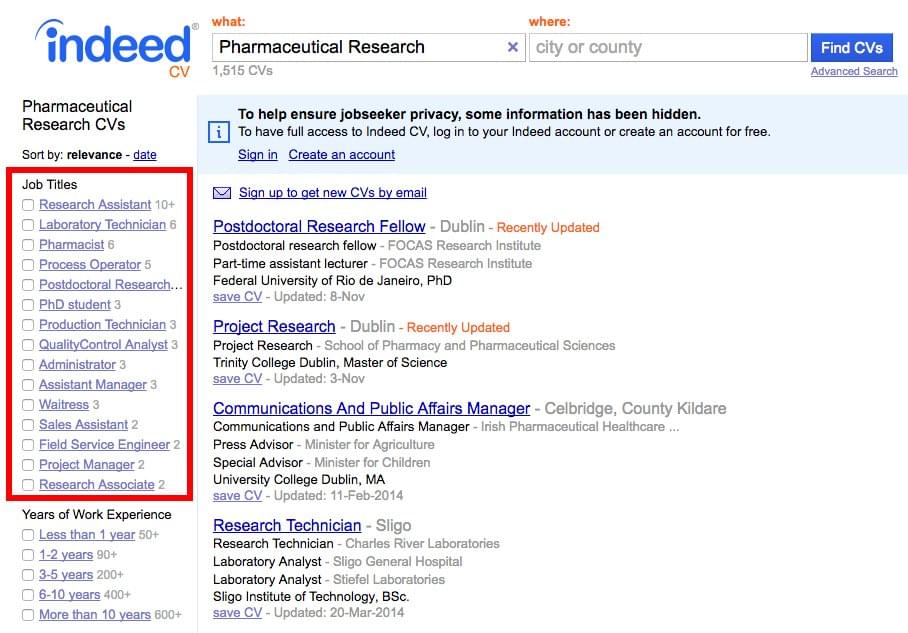
Therefore, when I come to posting a job ad for my role, I know that the best job title to advertise it under, is either Research Assistant or Laboratory Technician.
2. Who are the biggest employers for this type of talent in my location?
Where are most of the passive candidates with the skills I’m looking for? We can use Indeed’s CV database to determine who the biggest employers of people with the skills we’re looking for are. For example, you can see that when I run a general search for Pharmaceutical Research in Dublin on indeed.com/resumes, the top employers of candidates with this background is University College Dublin, followed closely by Trinity College Dublin.
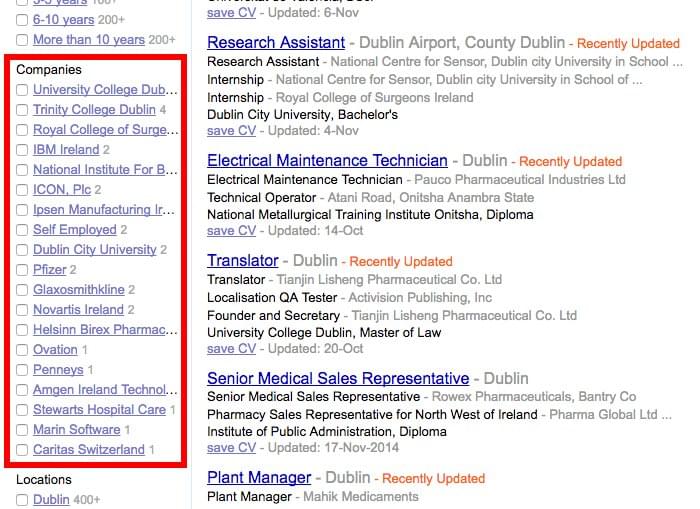
Having a good understanding of this is important because if the employers you identify have a big team of people with those skills, there’s a higher chance of you being able to poach out their talent. And if these companies are attracting so much of this talent to their organisation, it would be beneficial for you to do some research into how they attract that talent e.g. incentives, benefits, application process etc. Using this information, you will also be able to better inform your Hiring Manager as to where you might target to find people with these skills.
3. What’s the going salary rate for my role and who am I competing against for this talent right now?
Not only can we use Indeed’s CV/resume database, but as recruiters we can also use Indeed’s job search function as if we were a candidate. Doing so lets us in on some fantastic insights most particularly salary estimates for the role we have open and who we are competing with for that talent right now.
For example, if I want to get a benchmark of the salary for a senior level Research Assistant in New York, I’ll enter the job title and location into indeed.com. When the results page comes up, I will ignore the people my search has found and focus my attention on the filters on the left-hand side. There I can see a range of filters I can choose from. To determine the average salary for a senior level Research Assistant, I will select the ‘Senior level’ option from the ‘Experience level’ section. When I do so, a new set of results will appear along with updated filters on the left-hand side of the page. In the ‘Salary Estimate’ section, I can see that most senior level positions for Research Assistant’s in New York are being advertised from $45,000 upwards.
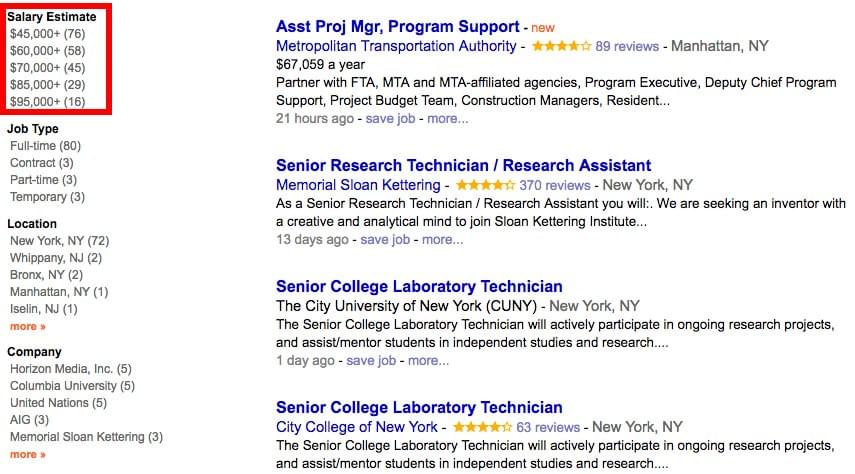
I can also delve further by selecting a specific location within New York, or by specifying whether the job is full-time, part-time or contract.
Use this data to consult with your hiring manager and HR teams and help them understand what the salary expectations for your open role might be out on the open market. Are you advertising at the going rate? Are you above or below the going rate? Or at the salary rate you’re offering, who are we competing with that’s out there looking for talent at the exact same time? When I specify my salary at $70,000, I can see that other organisations competing for talent at that salary level are Columbia University and AIG:
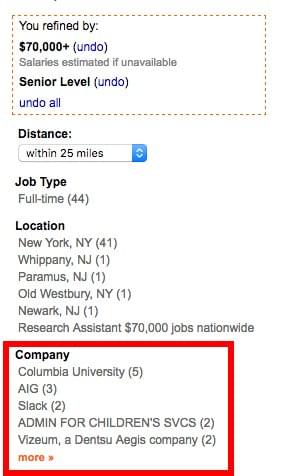
4. What are the current job trends surrounding the titles I’m hiring for?
One of the best features on Indeed is their Job Trends report which allows you to enter any job title and discover interesting statistics like the percentage of job seekers who have searched for e.g Research Assistant and Laboratory Technician jobs between 2012 and 2016. You can also discover the percentage of job postings for roles with these titles between 2012 and 2016, and the number of job seekers per posting over the years.
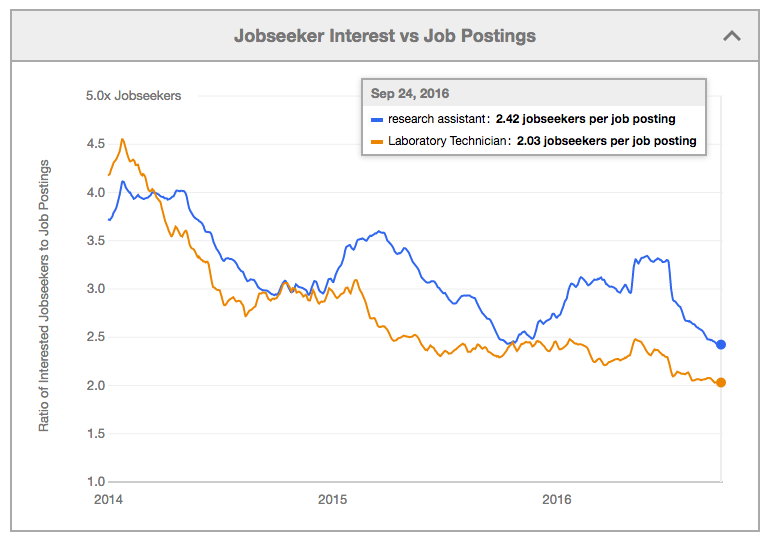
5. What is the demand for my role within the industry and what are the top keyword searches the candidates I’m looking for are performing on Indeed?
Another interesting and useful feature housed on Indeed (although only available with US industry information), is their Industry Employment Trends report. This report lets you delve into some pretty impressive high-level stats for a number of industries including healthcare, finance, IT, human resources, accounting, education, media and more. Take this example of the accounting industry:
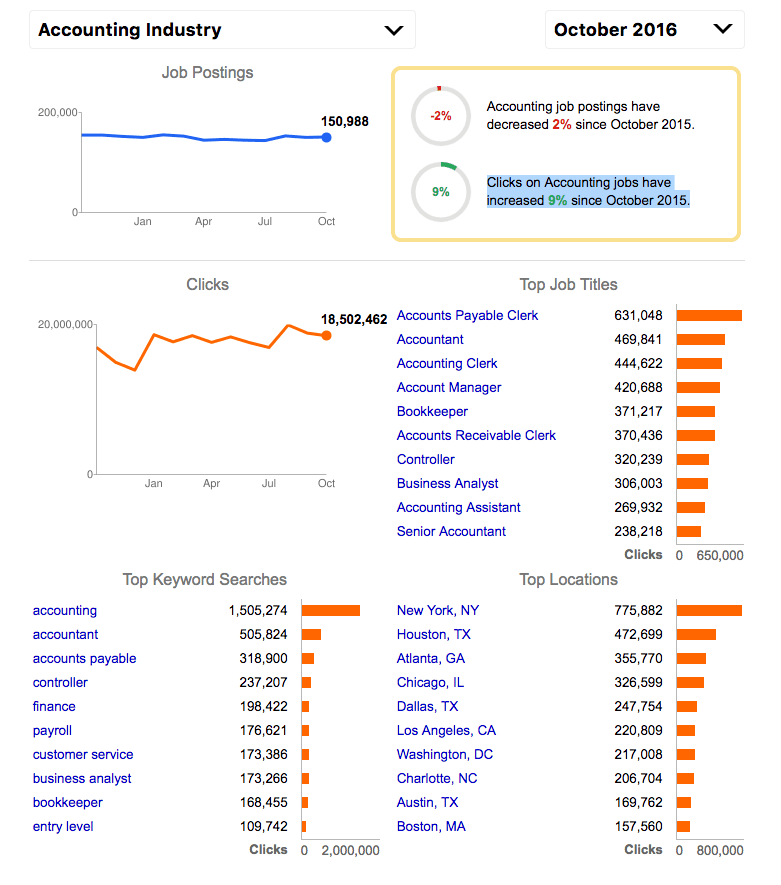
We can see that the number of accounting job postings have decreased 2% since October 2015, but clicks on accounting jobs have increased 9% since October 2015. We can also see the top keyword searches associated with the accounting industry (e.g, what accounting candidates are searching for on Indeed), the top US locations for accounting roles, and the top job titles associated with the accounting industry. This information is priceless when it comes to your recruitment research! So be sure to use it.
So there you have it, 5 clever ways you can use Indeed’s massive data store to better inform your own hiring efforts. As always, we’re keen to know how you get on when it comes to putting these techniques into practice as part of your own recruiting process, so do give us a shout on Twitter (@SocialTalent) or on LinkedIn. Or if you have any other ways that you use Indeed’s big data to your own advantage and you’d like to share them with us, we’d be delighted to see them!
Interested in learning even more clever recruitment research hacks? Our Black Belt in Internet Recruitment programme is packed full of practical, insightful and downright handy tips, techniques, hacks and more to help you get the most out of recruiters’ favourite professional networks. Request a free trial today!
